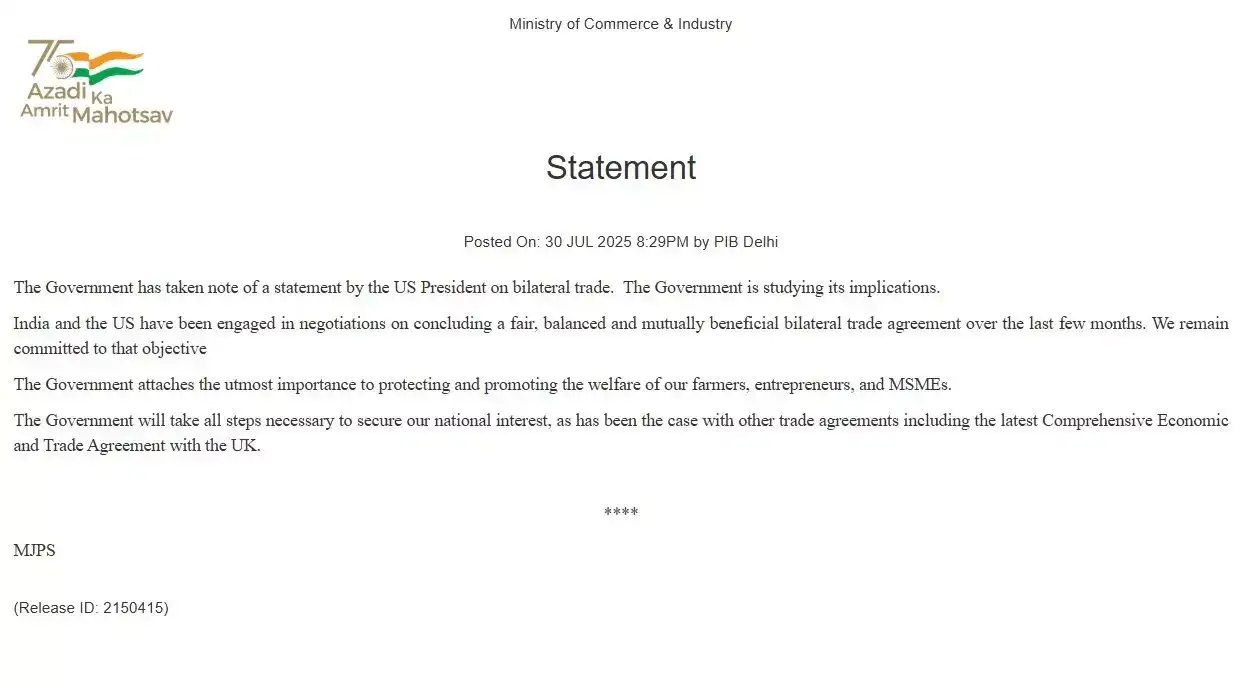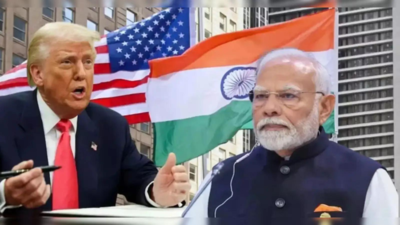NEW DELHI: The Centre on Wednesday responded to US president Donald Trump’s announcement of 25 per cent tariff on India saying it “has taken note of a statement by the US President on bilateral trade and the government is studying its implications.““India and the US have been engaged in negotiations on concluding a fair, balanced and mutually beneficial bilateral trade agreement over the last few months. We remain committed to that objective. The government attaches the utmost importance to protecting and promoting the welfare of our farmers, entrepreneurs, and MSMEs. The government will take all steps necessary to secure our national interest, as has been the case with other trade agreements including the latest Comprehensive Economic and Trade Agreement with the UK,” the statement said.

Trump, in a post on Truth Social announced that India will pay 25 per cent tariff from August 1 ‘plus penalty’ for buying Russian oil and military arms.The move came just a day after officials announced that a US trade delegation would visit New Delhi on August 25 for the sixth round of negotiations toward a bilateral trade deal. Trump’s sudden declaration is being viewed as a high-stakes pressure tactic as Washington secures favourable trade pacts with other key partners such as Japan, the UK, and the EU.In a post on his social media platform Truth Social, Trump said India’s trade practices were “among the highest in the world” and claiming the country imposed the “most strenuous and obnoxious non-monetary trade barriers of any country.”“All things not good! India will therefore be paying a tariff of 25%, plus a penalty for the above, starting on August first,” Trump wrote, referring to India’s continued energy and military purchases from Russia.Russia ties draw US ireIndia’s crude oil imports from Russia have soared since the Ukraine war began, jumping from a mere 0.2% of its energy portfolio to an estimated 35–40%. After China, India is now the second-largest buyer of Russian oil. Trump argued that at a time when the international community is urging Russia to end hostilities in Ukraine, India’s continued purchases of energy and defence equipment from Moscow send the wrong message.Although Trump acknowledged India as a “friend,” he said that US-India trade remained limited because of India’s steep tariffs and complex trade barriers. “We have, over the years, done relatively little business with them,” he added.In April, Trump had announced a global tariff hike of 26% on select trading partners, including India. That decision was paused for 90 days and extended through August 1 to allow time for trade talks. The baseline 10% tariff remains in effect.Further confusion surrounds the quantum and scope of the “penalty” Trump referred to, which appears separate from the 25% import tax.By comparison, the US currently imposes tariffs of 20% on Vietnam, 25% on Malaysia, 35% on Bangladesh, and 36% on Thailand.Trade talks to continueDespite the latest escalation, bilateral trade talks are set to continue. The upcoming US delegation, led by assistant US trade representative Brendan Lynch, will meet India’s chief negotiator Rajesh Agrawal in New Delhi in late August. The two sides concluded the fifth round of discussions in Washington earlier this year.Between 2021 and 2025, the US has been India’s largest trading partner, accounting for 18% of Indian exports and 6.2% of its imports.In FY 2024-25, bilateral trade between the two nations reached USD 186 billion, with India enjoying a trade surplus of USD 44.4 billion. India exported USD 86.5 billion worth of goods and imported USD 45.3 billion. In services, it posted a surplus of USD 3.2 billion.What’s at stakeIndia’s top exports to the U.S. in 2024 included:
- Drug formulations and biologicals: USD 8.1 billion
- Telecom instruments: USD 6.5 billion
- Jewellery and precious stones: USD 8.5 billion
- Petroleum products: USD 4.1 billion
- Auto components and garments: USD 5.6 billion combined
Imports from the US included:
- Crude oil and petroleum: USD 8.1 billion
- Coal and coke: USD 3.4 billion
- Aerospace parts, electric machinery, and gold: USD 4 billion combined
(With PTI inputs)
